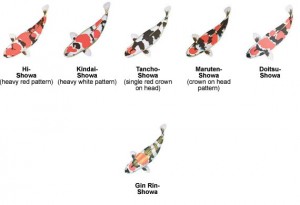showa
General Description
‘Taisho Sanshoku’, or ‘sanke’ is the term applied to a koi that has a white body with red and black markings. The black markings are in the form of spots that are generally confined to the body above the lateral line. Sanke as a koi breed was established around 1917.
Appreciation Criteria
The criteria for appreciating or judging a Sanke is the same as those of a Kohaku, with the addition of criteria for its black markings. In fact, it is said that a good Sanke is actually a good Kohaku that has been further enhanced by black spots that add elegance to the totality of the koi.
Color
The shiro (white) base color of the body must be unblemished, thick, snowy, and even milky. The shiro must not exhibit any yellowish tint.
The hi (red) markings on the white body must be solid, deep, and evenly-colored throughout the entire body. The edges of these markings (also known as the ‘kiwa’) must be very defined, or as they say, ‘sharp as a razor.’
The hi color may vary from koi to koi, but it should be of uniform hue within an individual koi. Different koi exhibit different hues, from a deep persimmon orange to dark, purplish red. This entire range is acceptable, although judges invariably have their own preferences.
The sumi (black) markings of a Sanke must be deep, solid, and shiny lacquer-black. The shape of every sumi spot must be clearly defined, with its kiwa or edges as sharp as possible. Undeveloped sumi (also known as ‘sashi’) may appear mottled dark blue or gray instead of solid black. This is not bad for a young koi, since sumi actually develops as the koi grows older. In fact, spotting a potential champion at a young age involves good anticipation of how well the sumi will develop in the next few years.
Pattern
The red and black markings on the white body must be artistically balanced. This means that a certain color must not be confined to one side or one end of the koi only.
The red-over-white pattern may be continuous or ‘stepped’, but the over-all effect of white and red balancing each other should be the ultimate consideration. Many people prefer stepped koi and understandably so, since this pattern ensures red and white alternating with each other. Sanke with a ‘hi’ pattern that runs continuously from head to tail is known as ‘aka sanke’. Aka sanke is less desired, since the predominantly red body makes it look heavy.
A white area separating the tail and the red marking nearest the tail is known as a tail stop, and is considered desirable. A red mark on the lips of a koi (also known as ‘kuchibeni’) is a ‘plus’ if it enhances the over-all package of the koi. A good sanke has a red pattern (but absolutely no black color) on the head. The head pattern must extend slightly beyond the eyes but should not reach the nose or lips, leaving a white area in the front end of the head. A fully red head (referred to as ‘menkaburi’) that makes the koi look ‘hooded’ is considered negative. Nonetheless, some koi look good despite having it, so don’t let it prevent you from buying a koi that you like.
A round patch of red on the head is considered nice. If this red patch is the only red marking on the sanke, then the koi is called a ‘tancho sanke’, a highly-prized koi variety among the Japanese since it looks like their national bird. If there are other red markings on the body of the koi, then the round head patch makes it a ‘maruten’ sanke.
The sumi of a sanke must be distributed in the koi body such that they collectively add balance to the koi. Their presence should enhance the ‘kohaku pattern’ and not degrade it. Old-style sanke koi are heavily endowed with sumi. Modern sanke exhibit a sparser distribution of sumi, but these should be clearly defined and solid black nonetheless. Koi experts also prefer sumi spots that are positioned over the white body. Conversely, sumi spots over hi markings are less desirable to them.

